| Lesson 2 | Roles of architecture and architect in e-business |
| Objective | Define architecture and role of the architect in ebusiness. |
Architect Roles in e-Business
To understand e-business architecture, we will start by defining the terms e-business and ecommerce. You may have heard these terms used interchangeably. The Internet itself is continually transforming, and these terms are redefined on an ongoing basis. In this course, we will define eCommerce, or what is sometimes termed iCommerce, to mean business transactions conducted online. This includes, for example, the actual transaction of buying and selling products and services using the Internet.
- e-business and ecommerce
How does e-business relate to the Internet? For the purposes of this course, we describe e-business as encompassing much more than the Internet, and more than eCommerce or iCommerce. e-business includes more than computers and the Web; it encompasses phone, fax, and more importantly, other yet-to-be invented electronic devices. We might even say that Internet was not the start of e-business, but that it has simply amplified its influence, particularly on the businesses-to-consumer (B2C) frontier.
The graphic below describes the relationship between e-business and eCommerce or iCommerce.
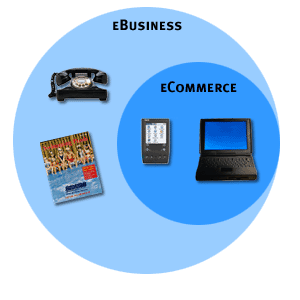
Now that we understand the relationship between e-business and eCommerce, let us discuss e-business architecture and the role of the e-business architect. Within this course, we will define e-business architecture as the structure or design of an e-business. To fully understand the e-business architects' role, it is important to appreciate the effect of introducing e-business into the traditional business environment.
e-business is still Business
The important thing to remember is that e-business is still business.
Although many companies make the assumption that e-business is separate from the existing business; this is often not the case. The digitalization, globalization, and deregulation that is so much a part of e-business, simply provides an alternative or additional route to market, and an automated way of doing more of today's business. There are many technical and operational differences between e-business and non-e-business activity. The focus may have shifted, but there are also many components that overlap and interact. We will now examine the e-business of redesign.
Although many companies make the assumption that e-business is separate from the existing business; this is often not the case. The digitalization, globalization, and deregulation that is so much a part of e-business, simply provides an alternative or additional route to market, and an automated way of doing more of today's business. There are many technical and operational differences between e-business and non-e-business activity. The focus may have shifted, but there are also many components that overlap and interact. We will now examine the e-business of redesign.
- Focus of e-business has Shifted
We can no longer define a company's assets in terms of property, equipment and inventory. The intangible elements, including- knowledge,
- customer loyalty and
- personalized service
have now become central to the business of e-business. Change has become continuous, and production continues to evolve. - Online Channels
Despite the early fascination with dot-com companies, there is a growing recognition that the Internet is unlikely to displace traditional channels anytime soon, at least in the world of business-to-consumer (B2C) commerce, with the exception of Amazon.com. Rather, many traditional enterprises have moved to integrate e-commerce into their channel mix, using the Internet to supplement existing brick-and-mortar retail channels. Electronic commerce researchers now consider the combination of physical and Web channels to be a distinct electronic commerce business model, most commonly referring to it as a "click-and-brick" or "click-and-mortar" approach.
Click and Brick | Channel Integration
In this module, a broad overview of the "click-and-brick" approach to e-commerce is provided. The focus is on the use of the click-and-brick approach by firms selling consumer products and services via a combination of physical and Internet retail channels, given the relative prevalence of this situation in the e-commerce arena. Much of the discussion is also relevant to other types of companies that rely on both Internet and physical channels, such as those involved in education and health care. In the first section, a brief look at the current e-commerce situation highlights the overall importance of taking an integrated brick-and-click approach to e-commerce development. A detailed examination of combining traditional and Internet-based channels is provided. The next section introduces the dangers of product and channel conflict and points out possible management strategies to improve channel integration. The last section highlights the potential benefits that firms may reap when pursuing a more integrated approach to e-commerce. Finally, the module closes with several conclusions regarding the importance of the click-and- brick approach in electronic commerce research and practice.
- Make Business Processes and B2B Relationships more Efficient
Recently, the focus of e-commerce has shifted from B2C ecommerce to the effective use of e-commerce tools to make business processes and B2B relationships more efficient. While practitioners are realizing this potential for using the internet to build profitable, long-term relationships with their trading partners, this topic has not received consideration from academic circles. In addition, the value of a high quality relationship, particularly the relationship between a service provider and their customers, is noteworthy in the service sector. Customers often rely on the credibility of service providers and their previous experiences with them due largely to the intangible nature of services. Furthermore, the production of many services requires that customers and service providers interact with one another. Customers' perceptions of the quality of the relationship with a service provider may be commensurate with the quality of the service itself. Therefore, a strong relationship between customers and the service provider brings about trust that is necessary for customers to commit to the service. We argue that relationship quality between trading partners and their business performance is enhanced through the use of the internet, with the internet affecting technical bonds more than social bonds. In the last six years, internet marketing literature has increased dramatically as a result of the rapid adoption of the internet in marketing.
The bulk of the early practitioner's literature on internet marketing was aimed at telling entrepreneurs how to go about establishing a place in the cyber market space, such as how to set up a web page. In the 1990s, academic attention focused on the revolutionary impact of internet technologies on the marketing discipline.
The e-business of Redesign
The goal of the e-business architect is to provide a unified view of the e-business and its effects on the existing business.
The successful e-business architect must therefore understand the overlap between business and e-business activities to ensure the success of the enterprise. He/she must focus on and consider new elements of business activity, but also be aware of the effects and interactions of these activities with existing practices and systems. The role of the e-business architect requires a very broad knowledge base. In a sense, the e-business architect is more accurately defined as a business re-designer, rather than an e-business architect. As you learn more about the scope of the architect's role, you will see why this distinction is important. Within the bounds of current technologies, it appears that some goods sell well electronically and others do not. Whatever the product, the architect's role in addressing the needs of the business is to look at new ways of addressing the customer. It is to act as an integrator, a translator, and a facilitator of the design process.
The following series of images below describes the role of the e-business architect:
The successful e-business architect must therefore understand the overlap between business and e-business activities to ensure the success of the enterprise. He/she must focus on and consider new elements of business activity, but also be aware of the effects and interactions of these activities with existing practices and systems. The role of the e-business architect requires a very broad knowledge base. In a sense, the e-business architect is more accurately defined as a business re-designer, rather than an e-business architect. As you learn more about the scope of the architect's role, you will see why this distinction is important. Within the bounds of current technologies, it appears that some goods sell well electronically and others do not. Whatever the product, the architect's role in addressing the needs of the business is to look at new ways of addressing the customer. It is to act as an integrator, a translator, and a facilitator of the design process.
The following series of images below describes the role of the e-business architect:
- Reaching Customer through High-touch and Low-touch Items
Goods and services that can take digital form are obvious examples of items that can be traded easily online.
Within the limits of current technology, some goods seem to sell well electronically and others do not. The simplest distinction here is between high-touch and low-touch products.
High-touch and low-touch items
High-touch items are those that customers prefer to see and feel before they buy. Historically, low-touch items have sold best on the Web to date, but the distinction is blurring.
High Touch versus Low Touch: High Touch is a business model that requires above average interaction with customers, whereas low touch requires minimal interaction and is transactional.Think of a KFC where the chicken is served either original or extra crispy. The drive through is a low-touch place where the customers can order over a microphone, pull up, swipe their card and say
High Touch versus Low Touch: High Touch is a business model that requires above average interaction with customers, whereas low touch requires minimal interaction and is transactional.Think of a KFC where the chicken is served either original or extra crispy. The drive through is a low-touch place where the customers can order over a microphone, pull up, swipe their card and say
I would like to have a 2 piece wing meal.High touch would be a restaurant where the waiter introduces himself or herself and says:
May I start you off with something to drink?Then talks about the guest's evening, recommends some meals, then offers wine based on their meal choices, and follows up with
Is anyone here interested in desert?
Virtual Realistic Previews
As noted previously, another benefit of Internet recruiting is that it may allow organizations to provide a virtual realistic preview to job applicants. Realistic job previews (RJP) are typically used to ensure that the naive expectations of job candidates are brought more in line with organizational realities. Most research on RJPs has shown that their use increases employee satisfaction levels and reduces turnover rates. Thus, organizations
have long used organizational brochures or videotapes to provide applicants with a realistic preview of the job or organizational environment. The Internet can easily and inexpensively be used to provide job candidates with a "virtual" preview of a job or show them what it is like to work for the organization. For example, Ford Motor Company presents applicants with a series of typical situations they might encounter on the job to ensure
that candidates know what to expect in the organization. Such "high-tech-high-touch"
approaches to RJPs should provide an important alternative to using brochures that are traditionally less flexible
and often more expensive than online systems. In addition, virtual job previews may offer more detailed,
current information than traditional brochures and allow candidates to personalize the recruitment process by indicating
their preferences for working arrangements (e.g., telework, on-site training).
- New ways of reaching the customer
The eBusiness solution must look at new ways of addressing the customer:- Expectations of direct ""touch and feel" interaction with the product
- Need for virtual personal, human guidance
- Acceptance of technologies supporting tailor-made or customized products
- Emerging solutions
In winning over the B2C customer, the online model gives up many of the benefits of the in-person hard sell, which is particularly important for the sale of big-ticket items. Although the list above describes some of the common challenges faced by eBusinesses today, with the rapid change of technology, solutions to these problems are emerging.

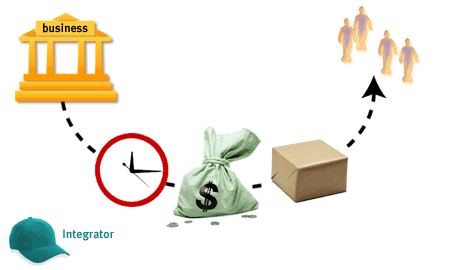
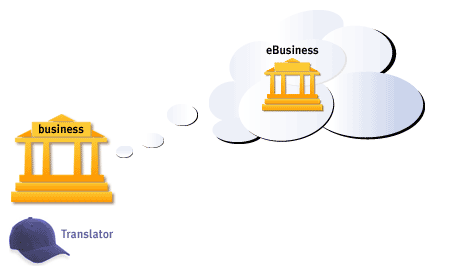
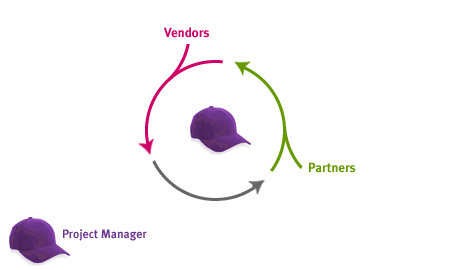
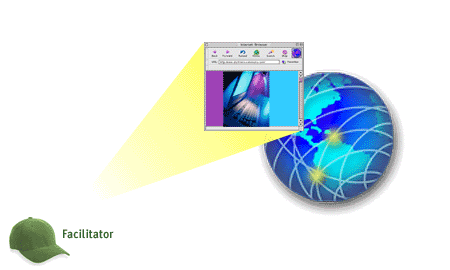
Roles of Architecture in e-Business
There are also a number of key concepts about business architecture that many organizations struggle with. There are multiple components that make up business architecture and business architecture comprises multiple components and organizations should adopt those that are most relevant. Each component depicts a different type of information and provides a different type of value. It is not only important to understand the components, but also how they relate to each other. Generally, there is not one single component, which is more important than another. However, depending upon what the business situation or problem dictates, certain components may provide more value than others. It is critical for a business architect to understand that the same component cannot be used to solve every business problem, but rather each problem is unique and the techniques needed to solve it are unique.
Business architecture is not just about the
Business architecture is not just about the
- strategy,
- business process,
- business capabilities, or
- the data.
e-business Architect Role - Quiz
Before you move on to the next lesson, click the Quiz link below to assess your understanding of scope of architect's role and responsibilities.
ebusiness Architect Role - Quiz
ebusiness Architect Role - Quiz